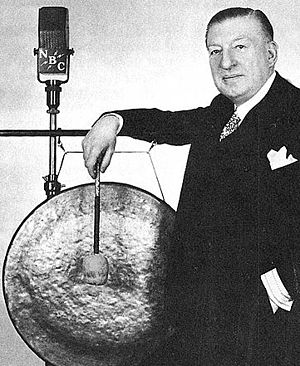- Major Bowes Amateur Hour
-
Major Bowes Amateur Hour, American radio's best-known talent show, was one of the most popular programs broadcast in the United States in the 1930s and 1940s. It was created and hosted by Edward Bowes (1874–1946).
In the 1920s Bowes was the imposing manager of New York's equally imposing Capitol Theatre and would insist on being addressed as "Major Bowes." He acted the part to the hilt, complete with military bearing and imperious manner. He once admonished an underling, "How will people think you're important if you don't act important?"
Contents
Radio
Bowes brought his amateur hour to the New York City radio station WHN in April 1934. On March 24, 1935, Chase and Sanborn chose this show to fill The Chase and Sanborn Hour on NBC. This arrangement only lasted until September 17, 1936, when the show moved to the CBS Radio Network. The show remained on CBS for the remainder of its run on radio.
Each week, Bowes would chat with the contestants and listen to their performances. He usually seemed vaguely impatient with the proceedings, and his constant refrain of "All right, all right" was lampooned by radio and films of the day. Bowes was known for his quick dispatch of untalented performers by sounding either a loud bell (similar to that used to denote the end of a boxing round) or a gong (thus inspiring a later series, The Gong Show).
Bowes's theatrical and managerial savvy extended the hit radio show into a profitable stage franchise. Bowes sent the more talented contestants on "Major Bowes" vaudeville tours, often with several units roaming the country simultaneously. Bowes presided over his radio program until his death on his 72nd birthday, June 14, 1946.
Tour
Major Bowes Amateur Hour also toured the US under the name Major Bowes Jamboree in 1938. The following performers appeared on the stage of Shea's Buffalo according to the June 2, 1938, Erie County Independent, Hamburg, NY, p 5.
It is composed of 12 prize winning acts which have never before appeared in Buffalo, with Ted Mack, former conductor of Shea's Buffalo Orchestra, returning in the role of master of ceremonies. On the screen will be Mickey Rooney, the delightful star of the Judge Hardy family series, in his newest role, "Hold That Kiss" with Maureen O'Sullivan and Dennis O'Keefe. Shea's Buffalo News will conclude the bill.
In the stage show, Major Bowes has booked some of the outstanding acts heard over his weekly radio program, most of which have just won honors within the past weeks. Among these are the Three Chords who startled the studio audience and radio listeners with their uncanny imitations of musical instruments and favorite bands, on the May 12 broadcast.
Bobby Blakeman, choir boy, who is called the Bobby Breen of the Major's hour, brings an unparalleled sweet voice to the program. Louise Boyd, the amateur Eleanor Powell, has a reputation for never missing a tap in her difficult routine; and the Wallace Brothers, two fast stepping youngsters from Harlem, will dance their way into the audience's heart.
Other entertainers include Ding, Dong and Dell, harmony trio; Harvey Mearns, Swiss bell ringer; Dick King, Imitator; Neva Ames, xylophone wonder; Duane Sister, acrobatic dancer, Adolph Robinson, song and danceman and Gae Allen, toe tapper on drums.
Ted Mack era
Ted Mack, who had supervised the auditions for Bowes, became the interim host of the radio show and a few months later moved it to the fledgling medium of television. It was intermittently broadcast on the DuMont Television Network during 1947 and began regular weekly programs January 18, 1948, still using Bowes' name in the title, Major Bowes' Original Amateur Hour. The TV show subsequently moved to each of the four commercial networks, eventually ending up on its original network, CBS, where the radio show continued to run until 1952. Starting with the 1950-51 season, both the radio and television versions became simply Original Amateur Hour and in 1955, the TV version was renamed Ted Mack and The Original Amateur Hour. Future stars who appeared on the show included Pat Boone and Gladys Knight.
Mack's style was decidedly more charitable than that of Bowes. The Major made a strong impression on a young Alan King, who had appeared on the Bowes program as a teen. He was discussing Bowes with Johnny Carson once, and suddenly stomped on the floor and yelled, "Can you hear me down there, Major Bowes?" suggesting that the late radio host had been consigned to Hell as punishment for his treatment of young performers.
In his comic monologue on his album Sinatra at the Sands (1966), Frank Sinatra describes how his vocal group The Hoboken Four's appearances were so popular on Major Bowes Amateur Hour in the mid-1930s that they were brought back week after week, under a different name each time.
External links
Categories:- American radio programs
- 1930s American radio programs
- 1940s American radio programs
Wikimedia Foundation. 2010.


